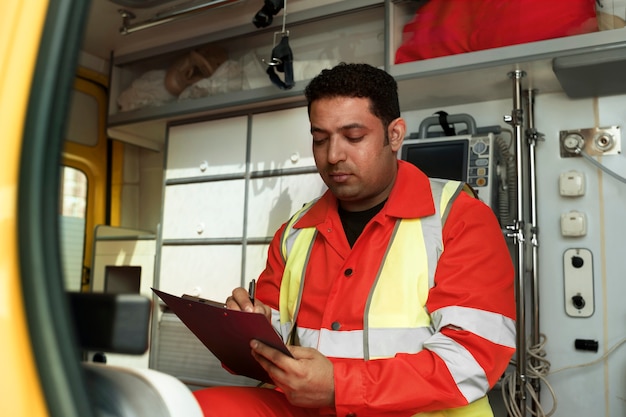Enhancing Emergency Response Coordination with Telephones and Public Safety
Enhancing Emergency Response Coordination with Telephones and Public Safety: Exploring the Vital Role of Phones in Crisis Management, Historical Evolution of Emergency Communication, and Effective Utilization of Communication During Critical Situations.

- Anthony Arphan
- 5 min read

In contemporary urban landscapes, the tools enabling swift and effective interaction during critical situations are pivotal. This section delves into the intricate networks of connections crucial for harmonizing responses to urgent incidents. By fostering seamless information exchange, local authorities and emergency services can navigate challenges more efficiently.
At the heart of effective community protection strategies lies the ability to synchronize efforts across diverse sectors. This segment explores the pivotal mechanisms that facilitate rapid communication and situational awareness, essential for safeguarding public well-being. By enhancing the orchestration of resources, communities are empowered to respond cohesively to unforeseen crises.
The Vital Role of Phones in Crisis Management
In times of critical situations, effective communication plays a pivotal role in managing and mitigating emergencies. One of the cornerstone components facilitating this communication are handheld devices that enable swift and reliable exchange of information among stakeholders. These devices serve as crucial tools, fostering rapid dissemination of vital updates and ensuring coordinated efforts without delay.
Moreover, these devices empower individuals to initiate emergency responses swiftly, amplifying the effectiveness of crisis management strategies. By leveraging the ubiquity and functionality of phones, responders can coordinate efforts efficiently, thereby enhancing overall preparedness and response capabilities in times of crisis.
Historical Evolution of Emergency Communication
In tracing the development of communication methods during critical situations, humanity’s journey through epochs reveals a profound transformation in how societies manage urgent incidents. Beginning from early epochs, where rudimentary methods sufficed for conveying distress signals, to the intricate systems employed today, the evolution mirrors broader technological advancements. Initially relying on basic signaling techniques, communities progressed towards more organized protocols, establishing networks designed to ensure swift and effective communication during crises.
- Primitive signaling methods
- Advancements in communication technologies
- Establishment of organized crisis communication networks
From Landlines to Mobile Phones
In the evolution of communication technologies aimed at public well-being, the transition from traditional fixed-line telecommunication systems to portable cellular devices marks a significant milestone. This shift not only revolutionized accessibility but also transformed the landscape of emergency responsiveness.
Initially tethered to specific locations, landlines were once the cornerstone of emergency communication infrastructure, providing reliable but limited reach. The advent of mobile phones introduced unparalleled mobility, enabling rapid and widespread access to emergency services in diverse scenarios.
The versatility of mobile devices has enhanced the agility of emergency responders, facilitating quicker coordination and real-time information dissemination. This evolution underscores a pivotal advancement in ensuring swift and effective public safety measures.
Adapting to Modern Technologies

In today’s interconnected world, staying responsive to dynamic technological advancements is crucial for ensuring efficient emergency management and fostering robust collaboration among responders. Embracing contemporary innovations allows for swift adaptation to evolving operational landscapes, facilitating streamlined communication and optimized resource allocation.
Exploring new tools and methodologies empowers emergency services to adjust swiftly to changing circumstances, enabling them to enhance their preparedness and improve their overall effectiveness in critical situations. By integrating cutting-edge technologies, responders can leverage real-time data analytics, facilitate rapid decision-making, and enable seamless coordination across diverse teams.
Effective Utilization of Communication During Critical Situations
In times of crisis, the strategic deployment of communication tools plays a pivotal role in ensuring swift and coordinated responses. Effective communication methodologies are crucial for facilitating rapid information dissemination and timely interaction among emergency responders and stakeholders. This section delves into the optimal utilization of telecommunications during emergencies, emphasizing the strategic leveraging of technological resources to enhance situational awareness and facilitate efficient collaboration.
Coordination Among Agencies

In fostering effective collaboration among various governmental bodies, seamless communication and joint planning are pivotal. This section delves into the mechanisms by which agencies synchronize efforts, ensuring cohesive responses to critical incidents and emergencies.
- Facilitating interagency communication through dedicated channels and protocols.
- Establishing unified command structures to streamline decision-making processes.
- Implementing interoperable technologies to enhance data sharing and situational awareness.
- Conducting regular joint exercises and drills to test response capabilities and identify areas for improvement.
- Promoting a culture of information exchange and mutual support across diverse organizational cultures.
By cultivating these practices, agencies fortify their ability to respond swiftly and effectively to complex challenges, safeguarding communities and optimizing resource allocation.
Public Awareness and Training
In this section, we explore the crucial role of community education and instructional programs in fostering public preparedness and knowledge regarding safety protocols. By raising awareness and providing comprehensive training initiatives, communities can effectively enhance their readiness to respond to critical situations.
Education campaigns serve as pivotal tools in disseminating essential information, ensuring that individuals grasp the significance of prompt and informed actions during emergencies. Through instructional workshops and interactive seminars, citizens gain practical insights into emergency procedures, bolstering their capacity to contribute effectively to community resilience.
Furthermore, training sessions equip participants with the skills needed to utilize available resources efficiently, promoting a cohesive approach to emergency preparedness. By instilling a culture of vigilance and proactive engagement, these initiatives empower communities to play active roles in safeguarding collective well-being.
Challenges and Innovations in Emergency Management
In the realm of urgent situations and critical incidents, modernizing response protocols remains a pivotal endeavor. The landscape of crisis management constantly evolves, demanding adaptive strategies and pioneering solutions. Addressing the intricacies of rapid intervention necessitates leveraging technological advancements and procedural innovations. Effective coordination amidst tumultuous events hinges upon the seamless integration of diverse resources and the cultivation of resilient networks. As challenges evolve, so too must the methodologies deployed to mitigate risks and ensure swift, coordinated responses.